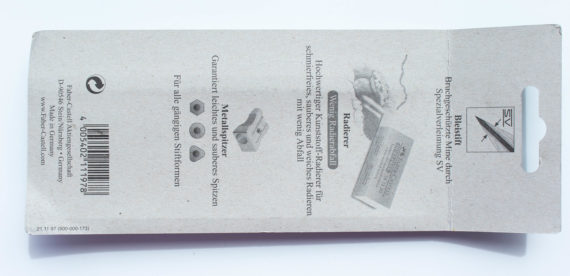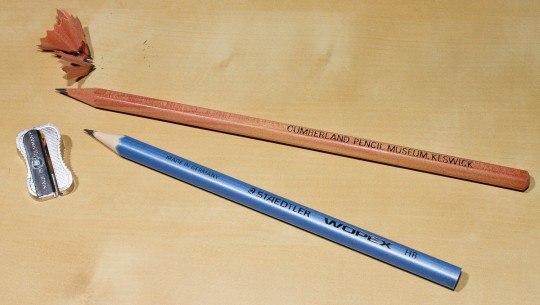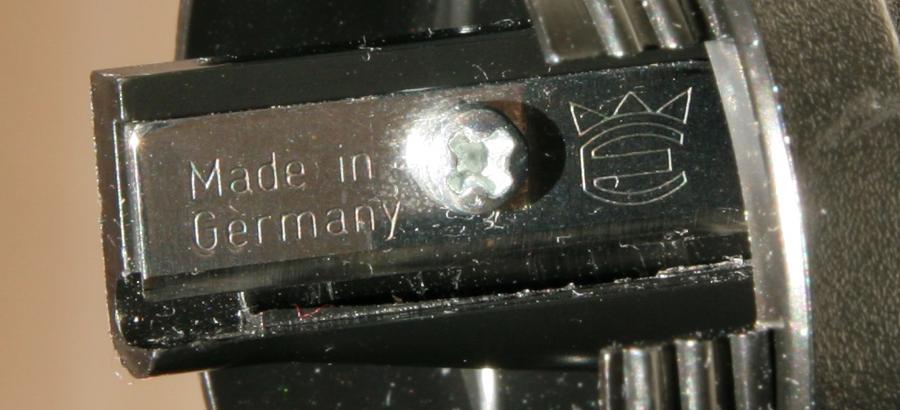Faber-Castell’s Goldfaber pencil set
Helping Hands
A few weeks ago David from Helping Hands Craft contacted me. He asked me if I want to review any of their products. I wasn’t aware of their shop before he contact me but was quite impressed by their selection of Faber-Castell products. As a review item I picked the Goldfaber pencil set for £4.50. Looking through their Faber-Castell items I was positively surprised to see other unusual items, for example
- the Faber-Castell’s erasing knife. In the past I couldn’t find this one anywhere in the UK, so Gunther sent me one from Germany,
- the Faber-Castell dusting brush, another rare find
- and the Polychromos anniversary set, even on offer.

The Goldfaber pencil set
Back to the less exotic Faber-Castell item I want to write about today: The Goldfaber set contains
- 4 Goldfaber HB pencils,
- a sharpener (presumably from Eisen [1]an underrated sharpener brand I have been occasionally mentioning over the last twelve years),
- and the big version of my favourite eraser [2]find out more in this 2010 blog post.
The Goldfaber pencils are made in Indonesia, just like the Columbus, its Irish cousin, and the Bonanza, its Arabic [3]The Bonanza used to be more widely available, but seems to be difficult to get outside the Middle East cousin. The pencil set is marked as being Made in Germany, so I was initially surprised and thought Goldfaber production has moved back to Germany, but when I checked with Faber-Castell they confirmed that this is a mistake and that they will fix this in the future. They have also confirmed that the Goldfaber is made in Indonesia. Unfortunately that’s as far as I got. My further request to get my suspicion regarding the wood being used confirmed was not successful.

Goldfaber 1221
The Goldfaber 1221 pencil is a nice writer. It is HB but writes darker than a Castell 9000 in B. I am not surprised though – I always found the 9000 to be lighter than similar grades in other pencils. Pearson’s Graphite 2015 confirms this, the Goldfaber HB is listed with a darkness of 12, the Castell 9000 B with a darkness of 8 [4]higher value = darker. The wood being used in the Goldfaber is also very good. For the price you pay the quality is excellent, but it can’t compete with high-end pencils from Faber-Castell or other brands. Out of the four pencils from the set one is slightly bent, two could have a better centred lead and all four don’t have a perfect paintjob. These small shortcomings don’t detract from the positive impression left by the dark graphite and the nice wood, especially not at this price [5]Eraser and sharpener are approximately half the value of the £4.50. There was also a faint smell of paint when the Goldfabers were fresh out of the box, something Faber-Castell’s Castell 9000 with its water-based varnish doesn’t suffer from, but the smell disappeared after a while.

Sharpener and eraser
The German-made sharpener, presumably an Eisen 040, does an excellent job, as does my favourite eraser, the Malaysian-made 187120, a dust free / no dust eraser.
Conclusion
Overall, this is a very nice pencil set, especially if you want a nice eraser and want a small sharpener and don’t need it to be a container sharpener.
Just to spell it out, I have not been paid for this blog post or for any other blog posts.
References
| ↑1 | an underrated sharpener brand I have been occasionally mentioning over the last twelve years |
|---|---|
| ↑2 | find out more in this 2010 blog post |
| ↑3 | The Bonanza used to be more widely available, but seems to be difficult to get outside the Middle East |
| ↑4 | higher value = darker |
| ↑5 | Eraser and sharpener are approximately half the value of the £4.50 |
Faber-Castell’s Goldfaber pencil set Read More »


















